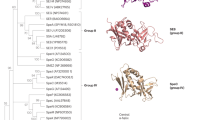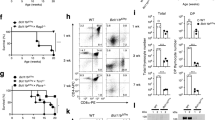Abstract
The development of many autoimmune diseases has been etiologically linked to exposure to infectious agents1. For example, a subset of patients with a history of Salmonella infection develop reactive arthritis2,3,4,5,6. The persistence of bacterial antigen in arthritic tissue and the isolation of Salmonella or Yersinia reactive CD8+ T cells from the joints of patients with reactive arthritis support the etiological link between Gram-negative bacterial infection and autoimmune disease7,8. Models proposed to account for the link between infection and autoimmunity include inflammation-induced presentation of cryptic self-epitopes, antigen persistence and molecular mimicry1. Several studies support molecular mimicry as a mechanism for the involvement of class II epitopes in infectious disease-induced self-reactivity9,10,11,12. Here, we have identified an immunodominant epitope derived from the S. typhimurium GroEL molecule. This epitope is presented by the mouse H2-T23-encoded class Ib molecule Qa-1 and was recognized by CD8+ cytotoxic T lymphocytes induced after natural infection. S. typhimurium-stimulated cytotoxic T lymphocytes recognizing the GroEL epitope cross-reacted with a peptide derived from mouse heat shock protein 60 and recognized stressed macrophages. Our results indicate involvement of MHC class Ib molecules in infection-induced autoimmune recognition and indicate a mechanism for the etiological link between Gram-negative bacterial infection and autoimmunity.
This is a preview of subscription content, access via your institution
Access options
Subscribe to this journal
Receive 12 print issues and online access
$209.00 per year
only $17.42 per issue
Buy this article
- Purchase on Springer Link
- Instant access to full article PDF
Prices may be subject to local taxes which are calculated during checkout



Similar content being viewed by others
References
Rose, N.R. The role of infection in the pathogenesis of autoimmune disease. Sem. Immunol. 10, 5–13 (1998)
Maki-Ikola, O. Reactive arthritis after unusual Salmonella infections. Lancet 336, 1387 (1990).
Granfors, K. et al. Salmonella lipopolysaccharide in synovial cells from patients with reactive arthritis. Lancet 335, 685–688 (1990).
Yu, D. & Inman, R. Infectious agents and other nongenetic immunologic factors in spondyloarthropathies. Curr. Opin. Rheumatol. 3, 581–585 (1991).
Taggart, A.J. & Bell, A.L. Reactive arthritis: a further consequence of the increase in salmonella infections Br. Med. J. 298, 674 (1989).
Kondowe, G.B., Bell, A.L., Middleton, D. & Taggart, A.J. An outbreak of Salmonella reactive arthritis in Northern Ireland. Ir. J. Med. Sci. 158, 274–277 (1989).
Hermann, E. T cells in reactive arthritis. APMIS 101, 177–186 (1993).
Sieper, J. & Braun, J. Pathogenesis of spondylarthropathies. Persistent bacterial antigen, autoimmunity, or both? Arthritis Rheum. 38, 1547–1554 (1995).
Hemmer, B. et al. Identification of high potency microbial and self ligands for a human autoreactive class II-restricted T cell clone. J. Exp. Med. 185, 1651–1659 (1997).
Wucherpfennig, K.W. & Strominger, J.L. Molecular mimicry in T cell-mediated autoimmunity: viral peptides activate human T cell clones specific for myelin basic protein. Cell 80, 695–705 (1995).
Gross, D.M., et al. Identification of LFA-1 as a candidate autoantigen in treatment-resistant Lyme arthritis. Science 281, 703–706 (1998).
Zhao, Z.S., Granucci, F., Yeh, L., Schaffer, P.A. & Cantor, H. Molecular mimicry by herpes simplex virus-type 1: autoimmune disease after viral infection. Science 279, 1344–1347 (1998).
Lo, W.-F., Ong, H., Metcalf, E.S. & Soloski, M.J. Cytotoxic T cell responses to Gram-negative intracellular bacterial pathogens: A role for CD8+ T cells in immunity to Salmonella infection and involvement of class Ib molecules. J. Immunol. 162, 5398–5406 (1999).
Aldrich, C.J. et al. Identification of a Tap-dependent leader peptide recognized by alloreactive T Cells specific for a class Ib antigen. Cell 79, 649–658 (1994).
Kurepa, Z. & Forman, J. Peptide binding to the class Ib molecule, Qa-1b. J. Immunol. 158, 3244–3251 (1997).
Imani, F. & Soloski, M.J. Heat shock proteins can regulate expression of the Tla region-encoded class Ib molecule Qa-1. Proc. Natl. Acad. Sci. USA 88, 10475–10479 (1991).
Koga, T. et al. T cells against a bacterial heat shock protein recognize stressed macrophages. Science 245, 1112–1115 (1989).
Lee, N., Goodlett, D.R., Ishitani, A., Marquardt, H. & Geraghty, D.E. HLA-E surface expression depends on binding of TAP-dependent peptides derived from certain HLA class I signal sequences. J. Immunol. 160, 4951–4960 (1998).
Braud, V.M. et al. HLA-E binds to natural killer cell receptors CD94/NKG2A, B and C. Nature 391, 795–799 (1998).
Zugel, U. & Kaufmann, S.H.E. Activation of CD8 T cells with specificity for mycobacterial heat shock protein 60 in Mycobacterium Bovis Bacillus Calmette-Guerin-vaccinated mice. Infect. Immun. 65, 3947–3950 (1997).
Hermann, E. et al. MHC-unrestricted recognition of bacteria-infected target cells by human CD8+ cytotoxic T lymphocytes. Cell. Immunol. 143, 253–260 (1992).
Life, P.F., Bassey, E.O.E. & Gaston, J.S.H. T-cell recognition of bacterial heat shock proteins in inflammatory arthritis. Immunol. Rev. 121, 113–135 (1991).
Russmann, H. et al. Delivery of epitopes by the Salmonella type III secretion system for vaccine development. Science 281, 565–568 (1998).
DeCloux, A., Woods, A.S., Cotter, R.J., Soloski, M.J. & Forman, J.F. Dominance of a single peptide bound to the class Ib molecule Qa-1b. J. Immunol. 158, 2193–2191 (1997).
Coico, R. Current Protocols in Immunology (John Wiley and Sons, New York, 1994).
Acknowledgements
We thank R. Siliciano, D. Pardoll, M. Schlissel and A. Rosen for their critical reading of the manuscript and suggestions. This work was supported by National Institutes of Health grants RO1AI20922 and RO1AI42287 and by an Award from the Maryland Chapter of the National Arthritis Foundation (M.J.S.) and by National Institutes of Health grants RO1AI32951 and USUHS R07FE (E.S.M.) and RO1GM54882 (R.J.C.).
Author information
Authors and Affiliations
Corresponding author
Rights and permissions
About this article
Cite this article
Lo, WF., Woods, A., DeCloux, A. et al. Molecular mimicry mediated by MHC class Ib molecules after infection with Gram-negative pathogens. Nat Med 6, 215–218 (2000). https://doi.org/10.1038/72329
Received:
Accepted:
Issue Date:
DOI: https://doi.org/10.1038/72329
This article is cited by
-
RNAseq analysis of hippocampal microglia after kainic acid-induced seizures
Molecular Brain (2018)
-
The role of MHC class Ib-restricted T cells during infection
Immunogenetics (2016)
-
A novel category of antigens enabling CTL immunity to tumor escape variants: Cinderella antigens
Cancer Immunology, Immunotherapy (2012)
-
T helper cell subsets in arthritis and the benefits of immunomodulation by 1,25(OH)2 vitamin D
Rheumatology International (2012)
-
Surface-associated Hsp60 chaperonin of Leptospira interrogans serovar Autumnalis N2 strain as an immunoreactive protein
European Journal of Clinical Microbiology & Infectious Diseases (2011)



